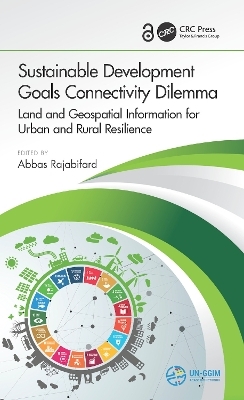
Sustainable Development Goals Connectivity Dilemma
CRC Press (Verlag)
978-0-367-25935-8 (ISBN)
The Open Access version of this book, available at https://doi.org/10.4324/9780429290626, has been made available under a Creative Commons Attribution-Non Commercial-No Derivatives 4.0 license.
Large-scale migration from rural to urban areas, and between countries, affects sustainable development at local, national, and regional levels. To strengthen urban and rural resilience to global challenges, Sustainable Development Goals Connectivity Dilemma: Land and Geospatial Information for Urban and Rural Resilience, brings together leading international geospatial experts to analyze the role of land and geospatial data infrastructures and services for achieving the United Nations' Sustainable Development Goals (SDGs). While the goals outlined in the 2030 Agenda have been longstanding aspirations worldwide, the complexity and connectivity between social, economic, environmental, and governance challenges are changing with large-scale urbanization and population growth. Structured in 5 parts, the themes and objectives of the book are in line with the critical challenges, gaps, and opportunities raised at all UN-GGIM events and UN-GGIM Academic Network forums. Through the different perspectives of scholars, industry actors, and policy-makers, this book provides interdisciplinary analysis and multisectoral expertise on the interconnection between the SDGs, geospatial information, and urban and rural resilience.
Sustainable Development Goals Connectivity Dilemma: Land and Geospatial Information for Urban and Rural Resilience is an essential reference for researchers, industry professionals, and postgraduate students in fields such as geomatics, land administration, urban planning, GIS, and sustainable development. It will also prove a vital resource for environmental protection specialists, government practitioners, UN-GGIM delegates, and geospatial and land administration agencies.
Features:
Introduces a holistic and new approach to sustainable development
Brings together social, economic, and environmental dimensions of sustainability
Highlights the significance and the role of geospatial information in sustainable development
Examines urban and rural interdependencies in the context of strengthening resilience
Written by experts with diverse academic and professional backgrounds who examine connectivity and develop strategic pathways
Prof Abbas Rajabifard is the Head of Department of Infrastructure Engineering at The University of Melbourne and the Chair UN-GGIM Academic Network. He is also Director of the Centre for Spatial Data Infrastructures & Land Administration (CSDILA).Prof Rajabifard is a member of Academic Board. He was President of the GSDI Association (2009-2012), Vice Chair of Working Group 3 of the United Nations supported Permanent Committee on GIS Infrastructure for Asia and the Pacific (PCGIAP), is a member of ICA-Spatial Data Standard Commission, and is a member of Victorian Spatial Council. He has been an Executive Board member and national representative to the PCGIAP (1994-1998), member of International Steering Committee for Global Mapping Project (1997-2001) and a member of the UN-ESCAP Group of Experts to develop Guidelines on GIS Standardisation for Asia-Pacific (1995). Prof Rajabifard has active research in the areas of SDI, Land Administration and land management, spatial enablement, spatial enabled government and societies, disaster management, 3D platforms and virtual jurisdictions.
Introduction. SDGs Roadmap: Setting the Scene. Spatial Enablement for Sustainable Development. Geospatial Information Enhancing SDG Connectivity. Links between Urban and Rural Resilience for Sustainability. Legal, Policies and Institutional Components. Technical and Enabling Tools. Way Forward and Future Direction.
| Erscheinungsdatum | 07.08.2019 |
|---|---|
| Zusatzinfo | 21 Tables, black and white; 66 Illustrations, black and white |
| Verlagsort | London |
| Sprache | englisch |
| Maße | 156 x 234 mm |
| Gewicht | 725 g |
| Themenwelt | Naturwissenschaften ► Biologie ► Ökologie / Naturschutz |
| Naturwissenschaften ► Geowissenschaften ► Geografie / Kartografie | |
| Technik ► Architektur | |
| ISBN-10 | 0-367-25935-4 / 0367259354 |
| ISBN-13 | 978-0-367-25935-8 / 9780367259358 |
| Zustand | Neuware |
| Haben Sie eine Frage zum Produkt? |
aus dem Bereich


